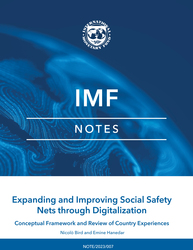
Agricultural Producer Subsidies: Navigating Challenges and Policy Considerations
Agricultural producer subsidies are prevalent, large, and can be inefficient and harmful to the environment. Furthermore, agricultural production subsidies are often fiscally costly and unfavorable compared to alternative uses of public funds.
READ MORE...
Volume/Issue:
Volume 2024
Issue 002
Publication date: August 2024
ISBN: 9798400285950
$5.00
Add to Cart by clicking price of the language and format you'd like to purchase
Available Languages and Formats
| English |
Prices in red indicate formats that are not yet available but are forthcoming.
Topics covered in this book
This title contains information about the following subjects.
Click on a subject if you would like to see other titles with the same subjects.
Economics- Macroeconomics , Public Finance , Agribusiness , Agricultural subsidies , direct farmer support , payments to agricultural producers , producer subsidy , input subsidy program , IMF note 2024/002 , output price subsidy , implementation challenge , Agricultural policy , Government subsidies , Agroindustries , Agricultural sector , Price incentives , Global , Sub-Saharan Africa
Also of interest
Summary
The objectives underlying agricultural output subsidies can have conflicting implications for the design of subsidy programs. As they tend to affect meaningful swaths of the electorate, subsidies can also be an attractive political instrument. By artificially lowering production costs or assuring higher output prices, direct support measures can result in resource misallocation in instances where they fail to address market failures, such as imperfect information about the returns to fertilizers. Subsidies can also contribute to fertilizer overuse, harming the environment and the agricultural sector in the long term. Furthermore, agricultural production subsidies are often fiscally costly and unfavorable compared to alternative uses of public funds—both within the agricultural sector and outside it—to achieve the same ends. Various design and implementation challenges amplify the shortcomings of producer subsidy programs.
Copyright © 2010 - 2025
Powered by:
AIDC



